
Reports of the Nandi Bear by westerns have been coming out of western Kenya, Africa from as early as the 1900s, however the native people have been encountering the beast for much longer. The creature takes its name from the Nandi people which call western Kenya their home. The Nandi people call the creature Kent and believe that when the Nandi Bear takes a human life, it only does so to eat the brains.  Described as being about the same size as a large lion and resembling that of a hyena with a brownish red to a dark color coat, the name Nandi Bear can be a bit misleading. The name comes from two factors, its frequent sightings by the Nandi people and its apparent bear like facial features and stride. The only known bear species in Africa, the Atlas Bear, which lived some distance away in the Atlas Mountains, is said to have gone extinct several decades ago due to over hunting by the Roman Empire, leaving us with one question, what is the Nandi Bear.
Described as being about the same size as a large lion and resembling that of a hyena with a brownish red to a dark color coat, the name Nandi Bear can be a bit misleading. The name comes from two factors, its frequent sightings by the Nandi people and its apparent bear like facial features and stride. The only known bear species in Africa, the Atlas Bear, which lived some distance away in the Atlas Mountains, is said to have gone extinct several decades ago due to over hunting by the Roman Empire, leaving us with one question, what is the Nandi Bear.
There are several theories as to what the Nandi Bear may be:
An Unknown Bear: The Nandi Bear is said to have many bear like qualities, its facial features and stride match those of known bears, and reports also say it is able to stand on its hind legs, another trait of known bears. The Nandi Bear is also reported to be able to climb trees, waiting for a possible victim to pass by. The physical features of the Nandi bear do have some resemblance to that of the extinct Atlas Bear, however the distance from the Atlas Mountains and lack of any fossil records in the area make that highly unlikely.  An Unknown Hyena: Perhaps the most likely candidate for the true identity of the Nandi Bear is that of a Hyena. It is thought that the Nandi bear may be an undiscovered giant hyena or even a prehistoric survivor. Fossil records show that during the Pleistocene there lived a hyena in Africa that was roughly it size of a modern lion called the Short-Faced Hyena. Being a much more active hunter, the Short-Faced Hyena would match many of the reported attacks by the Nandi Bear.
An Unknown Hyena: Perhaps the most likely candidate for the true identity of the Nandi Bear is that of a Hyena. It is thought that the Nandi bear may be an undiscovered giant hyena or even a prehistoric survivor. Fossil records show that during the Pleistocene there lived a hyena in Africa that was roughly it size of a modern lion called the Short-Faced Hyena. Being a much more active hunter, the Short-Faced Hyena would match many of the reported attacks by the Nandi Bear.  A Chalicothere: Some Zoologists feel that if the Nandi Bear truly does exist it may be a surviving Chalicothere, a sloped back animal related to horses which had large claws instead of hooves. Like the Short-Faced Hyena, the Chalicothere is thought to have gone extinct in the Pleistocene Era. It is believed that the creatures claws were used for digging up roots and possibly for defense.
A Chalicothere: Some Zoologists feel that if the Nandi Bear truly does exist it may be a surviving Chalicothere, a sloped back animal related to horses which had large claws instead of hooves. Like the Short-Faced Hyena, the Chalicothere is thought to have gone extinct in the Pleistocene Era. It is believed that the creatures claws were used for digging up roots and possibly for defense.
 If this was true, and the Chalicothere used its claws for defense, than an enraged Chalicothere would be capable of reported Nandi Bear attacks. Although being a herbivore, the Chalicothere does fit the general description of the Nandi Bear.
If this was true, and the Chalicothere used its claws for defense, than an enraged Chalicothere would be capable of reported Nandi Bear attacks. Although being a herbivore, the Chalicothere does fit the general description of the Nandi Bear.
 A Giant Baboon: The Nandi Tribe often describes the Nandi Bear as a large baboon like primate. Mark A. Hall and Loren Coleman agree that the Nandi Bear may be a form of unknown baboon, possibly another prehistoric survivor. Fossils indicate that a giant baboon twice the size of modern baboons once lived in Africa, and large baboon would be capable of reported Nandi Bear attacks. Baboons can also stand up straight and climb trees, a reported quality of the Nandi bear.
A Giant Baboon: The Nandi Tribe often describes the Nandi Bear as a large baboon like primate. Mark A. Hall and Loren Coleman agree that the Nandi Bear may be a form of unknown baboon, possibly another prehistoric survivor. Fossils indicate that a giant baboon twice the size of modern baboons once lived in Africa, and large baboon would be capable of reported Nandi Bear attacks. Baboons can also stand up straight and climb trees, a reported quality of the Nandi bear.
The Evidence
Besides hundred of sightings by westerners and reports that local people have killed the animal, there remains no physical evidence that the Nandi Bear exists.
The Sightings
In 1912, Major Toulson, a military settler upon the Uasin Gishu plain, had an encounter with a Nandi Bear. He reported the following to British anthropologist C.W. Hobley:
"... One of my boys came into my room and said that a leopard was close to the kitchen. I rushed out at once and saw a strange beast making off: it appeared to have long hair behind and was rather low in front. I should say it stood about 18 in. to 20 in. at the shoulder; it appeared to be black, with a gait similar to that of a bear--a kind of shuffling walk ...
Two well-known Kenya colonists, Major Braithwaite and Mr. C. Kenneth Archer gave one of the best accounts of the Nandi Bear. They saw an animal that they thought was a lioness at first; however they later noticed the impression of a snout. The beast stood very high forward, about 4 ft. 3 ins. to 4 ft. 6 ins. at the shoulder. "The back," they said, "sloped steeply to the hindquarters and the animal moved with a shambling gait which can best be compared with the shuffle of a bear. The coat was thick and dark brown in color. Finally, the beast broke into a shambling trot and made for a belt of trees near the river, where it was lost." Due to their experience, their story is not likely to be that of a misidentification. Their report is similar to others of the Nandi Bear. As a member of the Nandi Expedition in the early 1900's, Geoffrey Williams had an encounter with the Nandi Bear. He wrote the following in the Journal of the East Africa and Uganda Natural History Society:
"I was traveling with a cousin on the Uasingishu just after the Nandi expedition, and, of course, long before there was any settlement up there. We had been camped ... near the Mataye and were marching towards the Sirgoit Rock when we saw the beast ... I saw a large animal sitting up on its haunches no more than 30 yards away. Its attitude was just that of a bear at the 'Zoo' asking for buns, and I should say it must have been nearly 5 feet high ... it dropped forward and shambled away towards the Sirgoit with what my cousin always describes as a sort of sideways canter
I snatched my rifle and took a snapshot at it as it was disappearing among the rocks, and, though I missed it, it stopped and turned its head round to look at us ... In size it was, I should say, larger than the bear that lives in the pit at the 'Zoo' and it was quite as heavily built. The fore quarters were very thickly furred, as were all four legs, but the hind quarters were comparatively speaking smooth or bare ... the head was long and pointed and exactly like that of a bear ... I have not a very clear recollection of the ears beyond the fact that they were small, and the tail, if any, was very small and practically unnoticeable. The color was dark ..."
N.E.F. Corbett, the District Commissioner of Eldoret, reported another encounter with the Nandi Bear in March 1913:
"I was having lunch by a wooded stream, the Sirgoi River, just below Toulson's farm ... to my surprise I walked right into the beast. It was evidently drinking and was just below me, only a yard or so away ... it shambled across the stream into the bush ... [I] could not get a very good view, but am certain that it was a beast I have never seen before. Thick, reddish-brown hair, with a slight streak of white down the hindquarters, rather long from hock to foot, rather bigger than a hyena, with largish ears. I did not see the head properly; it did not seem to be a very heavily built animal."
Many reports of the Nandi Bear surfaced from workers of the Madadi Railway when it was under construction. One railway employee Schindler discovered a series of canine-like tracks. They were 8.5 inch-long tracks with five toes instead of four (like most dogs) and a rather long heel. The sketches he made of these tracks show their unique characteristics.
G.W. Hickes, an engineer in charge of building the railway throughout East Africa saw the Nandi Bear on March 8, 1913. He reported the following:
"It was almost on the line when I first saw it and at that time it had already seen me and was making off at a right angle to the line ... As I got closer to the animal I saw it was not a hyena. At first I saw it nearly broadside on: it then looked about as high as a lion. In color it was tawny--about like a black-mained lion--with very shaggy long hair. It was short and thickset in the body, with high withers, and had a short neck and stumpy nose. It did not turn to look at me, but loped off--running with its forelegs and with both hind legs rising at the same time. As I got alongside it, it was about forty or fifty yards away and I noticed it was very broad across the rump, had very short ears, and had no tail that I could see. As its hind legs came out of the grass I noticed the legs were very shaggy right down to the feet, and that the feet seemed large..."
Not long after Hickes had his sighting, a native servant saw an animal much like the one Hickes saw, but reported it to be standing on its hind legs. A subcontractor had seen the same animal or one like it and mentioned it having a thick mane, long claws, large teeth, and an upright stance of about six feet.
In 1919, a farmer named Cara Buxton related the following story:
"A short time ago a 'Gadett' [or geteit, another name for the Nandi Bear] visited the district. This name is given to the animal by the Lumbwa and signifies the 'brain-eater.' Its first appearance was on my farm, where the sheep were missing. We finally found all ten, seven were dead and three were still alive. In no case were the bodies touched, but the brains were torn out. During the next ten days fifty-seven goats and sheep were destroyed in the same way; of these thirteen were found alive ..."
The Stats (Where applicable)
Classification: Mammal
Size: About the size of a large modern day lion.
Weight: unknown
Diet: Carnivore
Location: Western Kenya, Africa
Movement: 4 legged stride
Environment: The varied terrain of Kenya, Africa
|